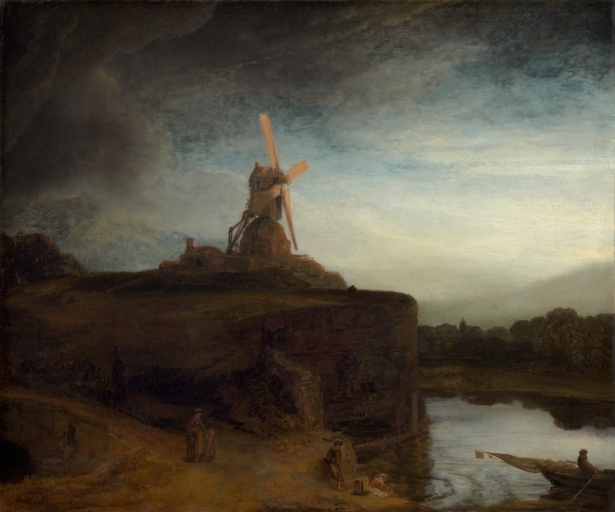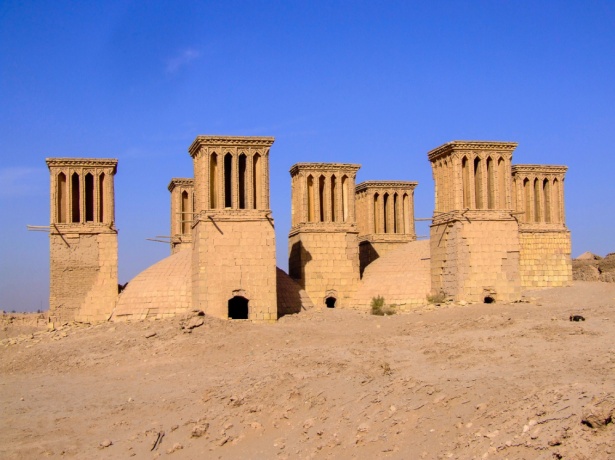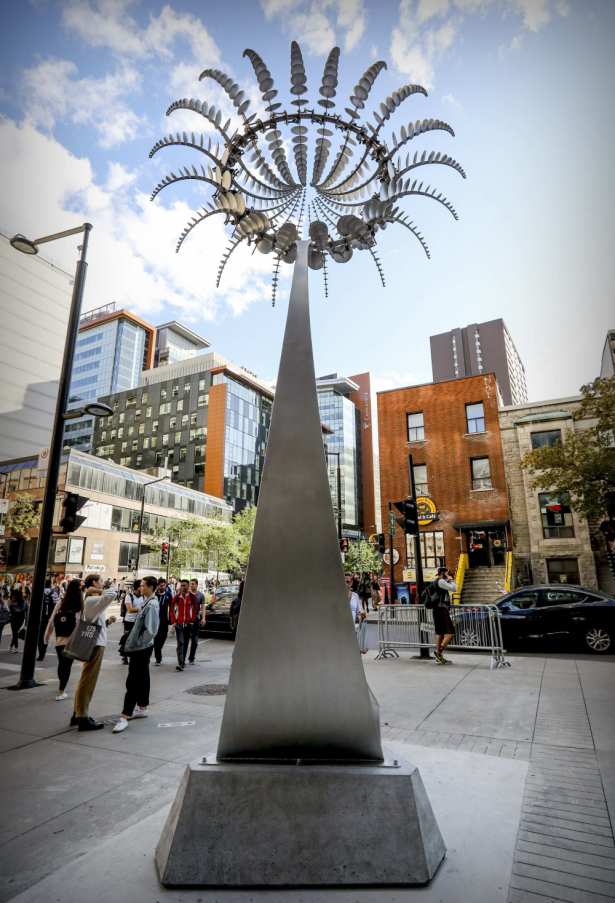This post comes from the Artists and Climate Change Blog
We humans have been harvesting the wind for at least 5,000 years. A clay vase dating to 3500 BCE from Egypt’s pre-dynastic Naqada II period depicts what is considered to be the world’s first clear image of a boat under sail. The square sail illustrated on this vase, presumably made of linen, was used to propel early Egyptian rudderless boats upstream on the Nile River, catching the northerly winds against the flow of the river.

Photo of the pre-dynastic Naqada II vase. Reprinted with permission from the British Museum online.
It would take another three millennia before humans transformed the wind’s kinetic energy into mechanical energy to operate machines to pump water, grind grain or mill wood. Early records suggest that by 200 B.C., simple windmills in China were pumping water. In 9th century Persia, vertical axis windmills with woven reed sails were grinding grain. In 14th century Europe, horizontal axis turbines were reclaiming land from low-lying marshland. By the 17th century, the Netherlands was home to approximately 9,000 windmills. Rembrandt’s The Mill, part of the National Gallery of Art’s Widener Collection in Washington, is widely considered to be one of his most famous paintings.

Rembrandt van Rijn (Dutch, 1606 – 1669), The Mill, 1645/1648, oil on canvas, Widener Collection 1942.9.62, National Gallery of Art.
But it wasn’t until the late 19th century that sapiens finally figured out how to convert the mechanical energy generated by a windmill into electricity. In 1887, the Scottish electrical engineer James Blyth built the first battery-charging wind machine that powered his cottage for 25 years. Later that same year, the American inventor Charles Brush built what is considered to be the first automatically operated wind turbine. It took another 100 years before multi-megawatt wind farms became commercially viable, prompted in part by the oil crises of the late 20th century.
But who, you might be asking, was the first artist to incorporate wind energy into a work of art? We may never know. Perhaps it was an ancient musician, who created – accidentally or intentionally – wind chimes of shells, bone, or bamboo. Wind chimes, a type of percussion instrument, are an example of chance-based music due to the randomness of the wind, which acts simultaneously as composer and player.
Or perhaps it was an Egyptian or Persian architect. Windcatchers (malqaf in Arabic; badgir in Farsi), also known as wind towers or wind chimneys, were a traditional Persian architectural roof-top structure designed to catch the prevailing winds to provide top-down natural ventilation and passive cooling within thick-walled buildings (often constructed partially or completely underground) in desert environments. So effective were windcatchers at cooling buildings that they were routinely used as a form of refrigeration in ancient Persia. The beautiful photo below of abandoned windcatchers near Yazd in central Iran was taken by Dave Ways.

Photo by Dave Ways, reprinted with permission from The Longest Way Home.
For a stunning contemporary interpretation of windcatchers, look no further than avant-garde Paris-based Belgian architect Vincent Callebaut’s The Gate Heliopolis, currently under construction in Cairo. Callebaut’s design includes nine oval “mega-trees†which function as giant windcatchers to suck prevailing winds deep into the heart of the building as natural (and free!) air conditioning in Cairo’s hot urban environment.


Another example of a contemporary artist inspired by wind energy is the renowned American sculptor Anthony Howe. I first wrote about Mr. Howe’s hypnotic wind-powered kinetic sculpture back in 2014. Since then, whenever I needed a creative fix – to be carried away by the beauty of his hypnotic artworks – all I had to do was visit his YouTube channel and start clicking away…
A 2016 headline in the Dallas News says it all: “Anthony Howe creates art that seeks to slow your heartbeat down and make your life better.†I promise you: this is not hyperbole!
In case you missed the opening ceremony of the Rio 2016 Summer Olympics, here is a video link of Mr. Howe discussing his massive two-tonne cauldron being “lit†by the olympic flame. In an interview with PR Newswire, Mr. Howe explained that his olympic vision was “to replicate the sun, using movement to mimic its pulsing energy and reflection of light. I hope what people take away from the cauldron, the Opening Ceremonies, and the Rio Games themselves is that there are no limits to what a human being can accomplish.â€
We Canadians are the lucky recipients of one of Mr. Howe’s most recent installations, right in the middle of downtown Montréal. Last year, Concordia University’s chancellor Jonathan Wener and his wife Susan donated Di-Octo II to their alma mater in honor of the 375th anniversary of Montréal and the 150th anniversary of Canada. This eight-meter-high kinetic sculpture now graces the northeast corner of De Maisonneuve Ouest and Mackay Streets.

Photo by John Mahoney, Montreal Gazette, September 2017.
Although most of Mr. Howe’s sculptures are powered by the wind, they do not (yet!) generate electricity. Perhaps we will have to leave this challenge to the next generation of kinetic sculptors. In the meantime, the Land Art Generator Initiative (LAGI) is leading the way: encouraging artists and architects around the world to adopt “solution-based art practice†by designing public art and sustainable infrastructure that generate renewable energy within urban environments. One of their visions: clean power stations as tourist attractions.
We’ve come a long way since 3500 BCE. In fact, we’ve come full circle, back to the future: the very first energy revolution was renewable (wood, wind, water); the second was coal; the third was oil; and the fourth – which we are currently living through – is renewable once again. But tighten your seat belts! This time around, the 21st century version of the renewable energy revolution portends virtual power plants, energy democracy and the break up of energy monopolies within our lifetimes. The Holy Grail is finally within reach: a post-carbon economy. Artists can help get us there faster by creating positive stories of clean abundance and endless possibilities.
(Top image: Wind turbines by Joan Sullivan.)
______________________________
Joan Sullivan is a renewable energy photographer based in Québec, Canada. Since 2009, Joan has focused her cameras (and more recently her drones) exclusively on the energy transition. Her goal is to create positive images and stories that help us embrace the tantalizing concept that the Holy Grail is finally within reach: a 100% post-carbon economy within our lifetimes. Joan collaborates frequently with filmmakers on documentary films that explore the human side of the energy transition. She is currently working on a photo book about the energy transition. Her renewable energy photos have been exhibited in group shows in Canada, Italy and the UK. You can find Joan on Twitter and Instagram.Â
Artists and Climate Change is a blog that tracks artistic responses from all disciplines to the problem of climate change. It is both a study about what is being done, and a resource for anyone interested in the subject. Art has the power to reframe the conversation about our environmental crisis so it is inclusive, constructive, and conducive to action. Art can, and should, shape our values and behavior so we are better equipped to face the formidable challenge in front of us.


